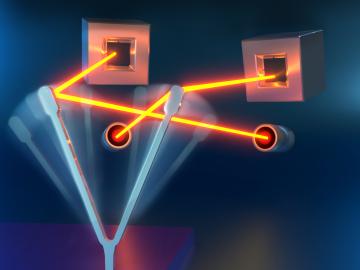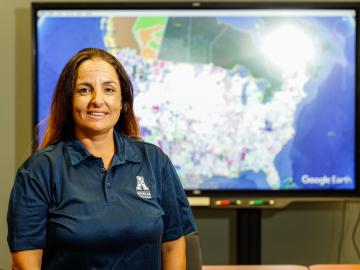
Filter News
Area of Research
- (-) Energy Science (77)
- (-) Fusion Energy (7)
- (-) Materials (85)
- (-) Neutron Science (29)
- Advanced Manufacturing (2)
- Biology and Environment (61)
- Biology and Soft Matter (1)
- Computational Biology (2)
- Computational Engineering (3)
- Computer Science (11)
- Electricity and Smart Grid (3)
- Energy Frontier Research Centers (1)
- Functional Materials for Energy (1)
- Fusion and Fission (12)
- Isotopes (1)
- Materials for Computing (9)
- Mathematics (1)
- National Security (25)
- Nuclear Science and Technology (13)
- Nuclear Systems Modeling, Simulation and Validation (1)
- Quantum information Science (9)
- Sensors and Controls (1)
- Supercomputing (110)
News Topics
- (-) Advanced Reactors (15)
- (-) Artificial Intelligence (16)
- (-) Grid (40)
- (-) High-Performance Computing (11)
- (-) Nanotechnology (45)
- (-) Physics (30)
- (-) Quantum Science (16)
- 3-D Printing/Advanced Manufacturing (92)
- Big Data (8)
- Bioenergy (34)
- Biology (19)
- Biomedical (23)
- Biotechnology (5)
- Buildings (38)
- Chemical Sciences (35)
- Clean Water (11)
- Composites (19)
- Computer Science (44)
- Coronavirus (23)
- Critical Materials (19)
- Cybersecurity (11)
- Energy Storage (88)
- Environment (67)
- Exascale Computing (3)
- Fossil Energy (3)
- Frontier (5)
- Fusion (19)
- Hydropower (3)
- Irradiation (1)
- Isotopes (13)
- ITER (1)
- Machine Learning (12)
- Materials (100)
- Materials Science (99)
- Mathematics (3)
- Mercury (3)
- Microelectronics (1)
- Microscopy (29)
- Molten Salt (3)
- National Security (7)
- Neutron Science (128)
- Nuclear Energy (30)
- Partnerships (16)
- Polymers (22)
- Quantum Computing (4)
- Security (8)
- Simulation (4)
- Space Exploration (8)
- Statistics (1)
- Summit (10)
- Transportation (72)
Media Contacts

To better determine the potential energy cost savings among connected homes, researchers at Oak Ridge National Laboratory developed a computer simulation to more accurately compare energy use on similar weather days.

As scientists study approaches to best sustain a fusion reactor, a team led by Oak Ridge National Laboratory investigated injecting shattered argon pellets into a super-hot plasma, when needed, to protect the reactor’s interior wall from high-energy runaway electrons.

Students often participate in internships and receive formal training in their chosen career fields during college, but some pursue professional development opportunities even earlier.

Researchers at ORNL and the National Renewable Energy Laboratory took inspiration from flying insects to demonstrate a miniaturized gyroscope, a special sensor used in navigation technologies.

The U.S. Department of Energy announced funding for 12 projects with private industry to enable collaboration with DOE national laboratories on overcoming challenges in fusion energy development.

In a recent study, researchers at Oak Ridge National Laboratory performed experiments in a prototype fusion reactor materials testing facility to develop a method that uses microwaves to raise the plasma’s temperature closer to the extreme values

Isabelle Snyder calls faults as she sees them, whether it’s modeling operations for the nation’s power grid or officiating at the US Open Tennis Championships.

IDEMIA Identity & Security USA has licensed an advanced optical array developed at Oak Ridge National Laboratory. The portable technology can be used to help identify individuals in challenging outdoor conditions.

Using additive manufacturing, scientists experimenting with tungsten at Oak Ridge National Laboratory hope to unlock new potential of the high-performance heat-transferring material used to protect components from the plasma inside a fusion reactor. Fusion requires hydrogen isotopes to reach millions of degrees.

A new method developed at Oak Ridge National Laboratory improves the energy efficiency of a desalination process known as solar-thermal evaporation.


